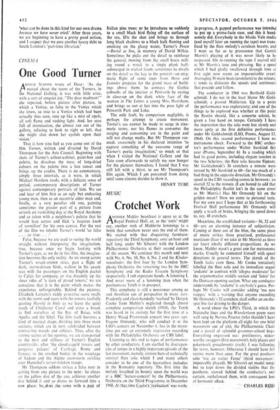Crotchet Work
MUSIC ANOTHER Mahler beanfeast is upon us at the .nkRoyal Festival Hall, or, as the 'antis' might say, another rush of Mahlerite lemmings to a brink that somehow never sees the end of them. We started with that disquieting furniture- repository the Third Symphony, over an hour and half long, under Mr Silvestri with the London Philharmonic Orchestra at their second concert of the season. We continue this month and next with No. 6, No. 10, No. 4, No. 2 and the Kinder- totenlieder, the first four by the London Sym- phony Orchestra, the remaining two by the BBC Symphony and the Radio Eireann Symphony respectively. I rub expectant hands. A lemming I. And never more of a lemming than when the posthumous Tenth is in prospect.
This symphony is still a newcomer among us and therefore out of perspective in many ears. Prudently and clean-handedly 'realised' by Deryck Cooke from Mahler's neglected though almost complete composition sketch (1910), the Tenth was heard in its entirety for the first time at a Henry Wood Promenade concert two years ago. Eugene Ormandy, who will conduct it at the LSO's concert on November 6, has in the mean- time put out an extremely impressive recording with the Philadelphia Orchestra on CBS label.
Listening to this and to tapes of performances by other conductors, I am startled by discrepan- cies of tempo in a highly important episode of the last movement, namely, sixteen bars of technically seminal flute solo which I and many others consider to be one of the heavenliest melodies in the Romantic repertory. The first time the melody breathed its bounty upon the world was at a BBC 'lecture-concert' by the Philharmonia Orchestra on the Third Programme in December 1960. At_tbn,tirne cs;cealisfition' w4s work.: in-progress, A gapped performance was intended to put up a prima-facie case, and this it hand- somely did. Everybody in the Maida Vale studio (and myself later on running the tape) was trans- fixed by the flute melody's cerulean beauty, and I went so far as to pronounce that Gareth Morris's playing of it was never likely to be surpassed. On re-running the tape I marvel still at Mr Morris's tone and phrasing. Rut a speed which I had gladly swallowed through love at first sight now seems an impermissible crawl. Averaging 36 main beats (crotchets) to the minute, i: tends to dislocate the speeds and sentiments that precede and follow.
The conductor in 1960 was Berthold Gold- schmidt. I do not in the least blame Mr Gold- schmidt, a proved Mahlerian. Up to a point the performance was exploratory; and one of the things to be explored was whether at this point the flautist should, like a concerto soloist, be given a free hand on tempo. Certainly I have the impression that the solo went less slowly and more aptly at the first definitive performance under Mr Goldschmidt (ISO, Proms, August 13, 1964). On this second performance I have no metronome check. Forward to the BBC orches- tra's performance under Walter Susskind this year (Proms, September 6). In a reading which had its good points, including elegant touches in the two Scherzos, the flute solo became flippant. Mr Goldschmidt's 36 crotchets a minute were revved by Mr Susskind to 60—far too much of a bad thing in the opposite direction. Mr Ormandy's speed in the CBS recording comes in between: an overall 52 to the minute. (I am bound to add that the Philadelphia flautist isn't in the same street as Mr Morris.) Has Mr Ormandy hit on the golden mean? Here we come to personal taste. For my own part I hope that at his forthcoming Festival Hall performance Mr Ormandy will apply a touch of brake, bringing the speed down to, say, 48 crotchets.
Meantime, the established variants-36, 52 and 60—are an alarming instance of subjectivism. Coming at them out of the blue, the same piece of music strikes three practised, professional musicians (four if we take in Mr Morris) as three (or four) wholly different propositions. As we know, Mahler wasn't a great one for metronome marks. Usually he contented himself with speed directions in general terms. The sketch of the Tenth lacks even these. Mr Cooke tentatively labelled the flute solo and its immediate sequel 'andante' in contrast with 'allegro moderato' for the argumentative middle section and 'lento' for the Dantean opening section. What any conductor understands by 'andante' is anybody's guess. Per- haps Mr Cooke will consider adding 'ma non troppo,' with a warning that. anyone exceeding Mr Ormandy's 52 crotchets shall suffer an on-the- spot fine for driving to the danger.
A word about the LPO's Third, in which the Nietzsche lines and the Wunderhorn poem were well sung by Norma Proctor (who shouldn't have been kept on the platform all night for one brief movement out of six), the Philharmonic Choir and a parcel of splendid grammar-school boys. Everything engrossed me: prettinesses, wince- worthy swaggers (first movement), holy places and pokerwork preachments (sixth). I was following the score, however. Otherwise I should have felt restive more than once. For the great posthorn solo `wie an weiter Ferne' (third movement: impeccably played), Mr Silvestri set model tempi but so kept down the divided violins that the posthorn, stowed behind the conductor's exit curtain, outbalanced them, with consequent loss of harmonic effect.
'" CHARLES- ROD


































 Previous page
Previous page